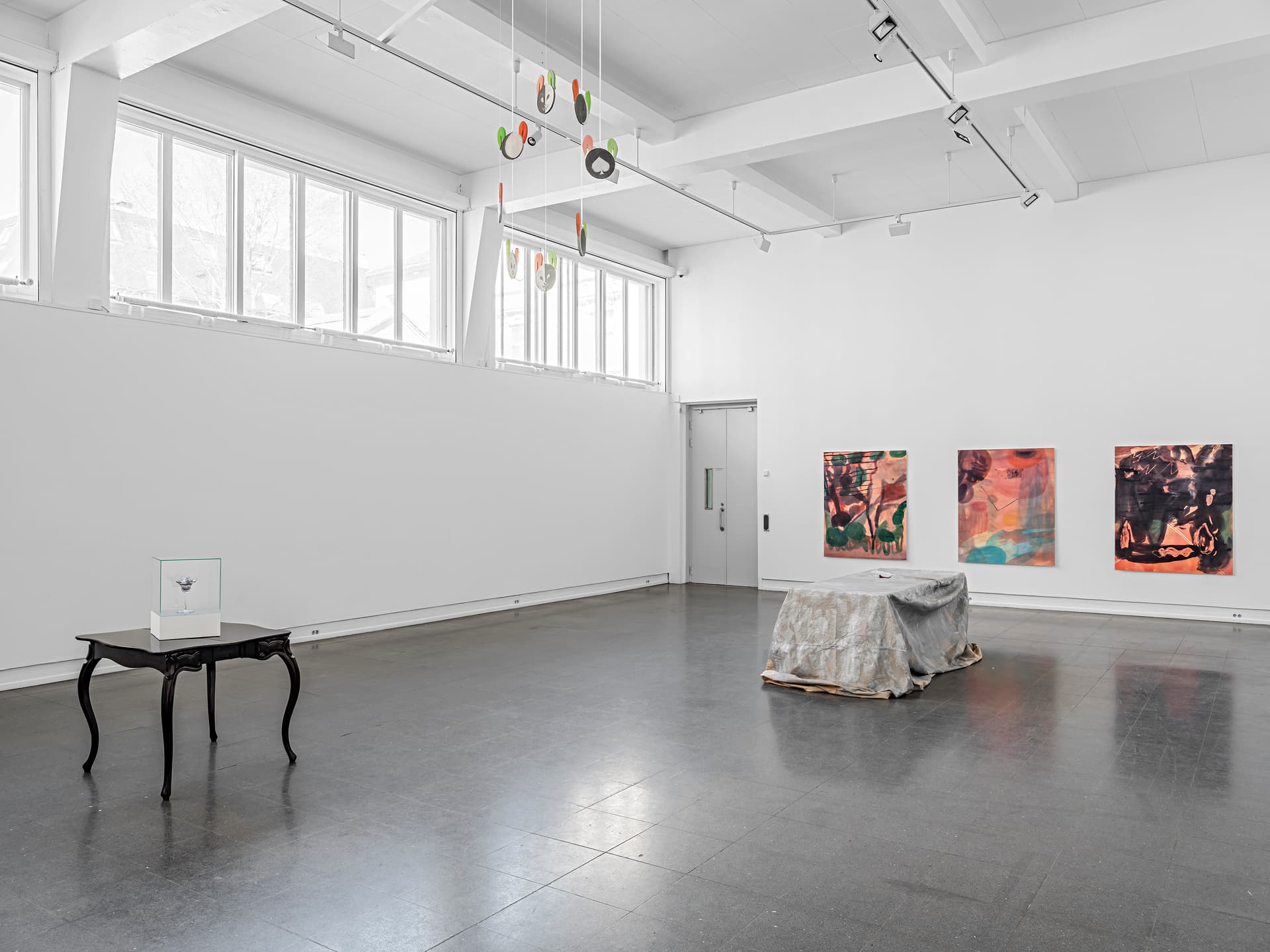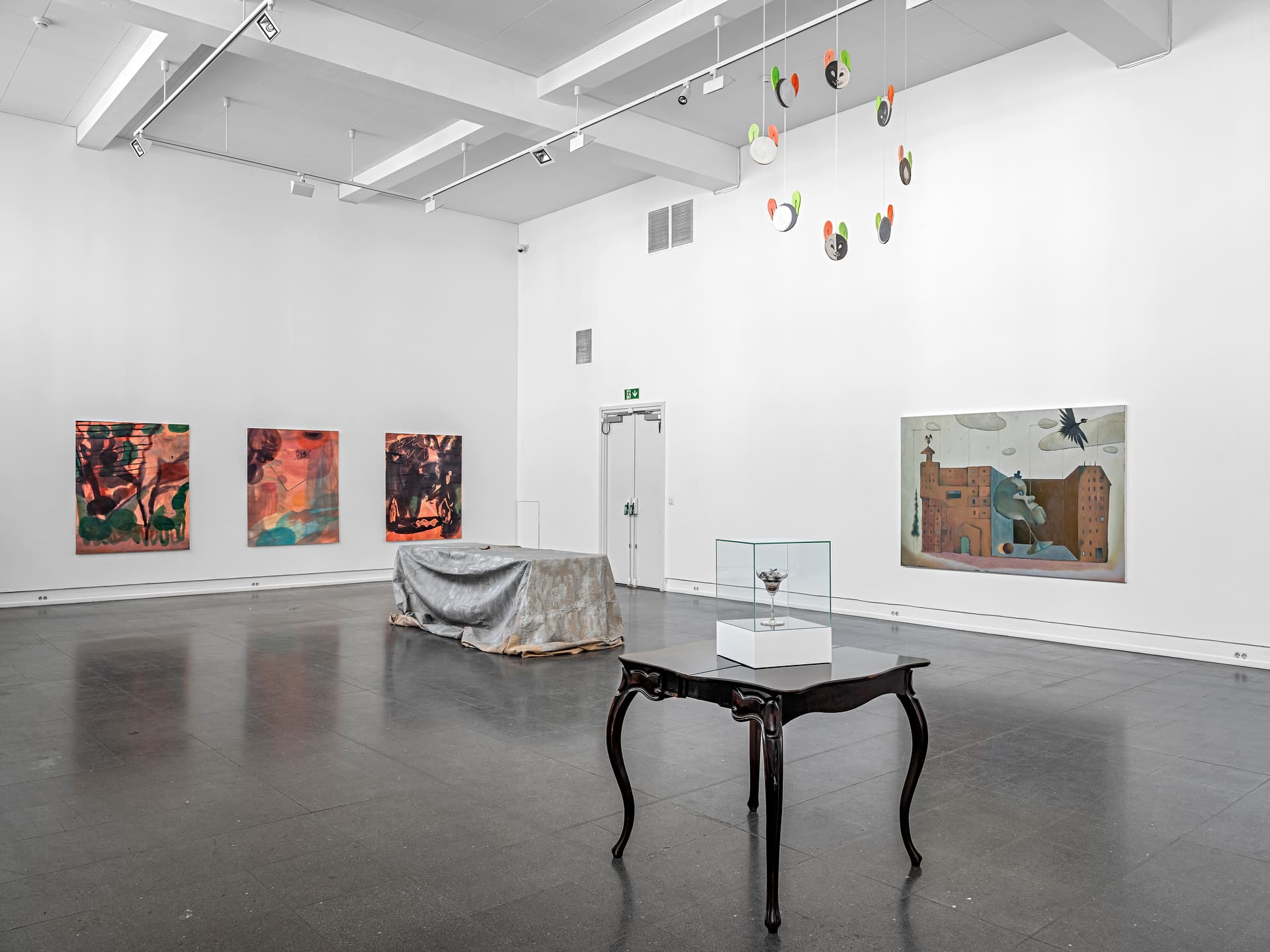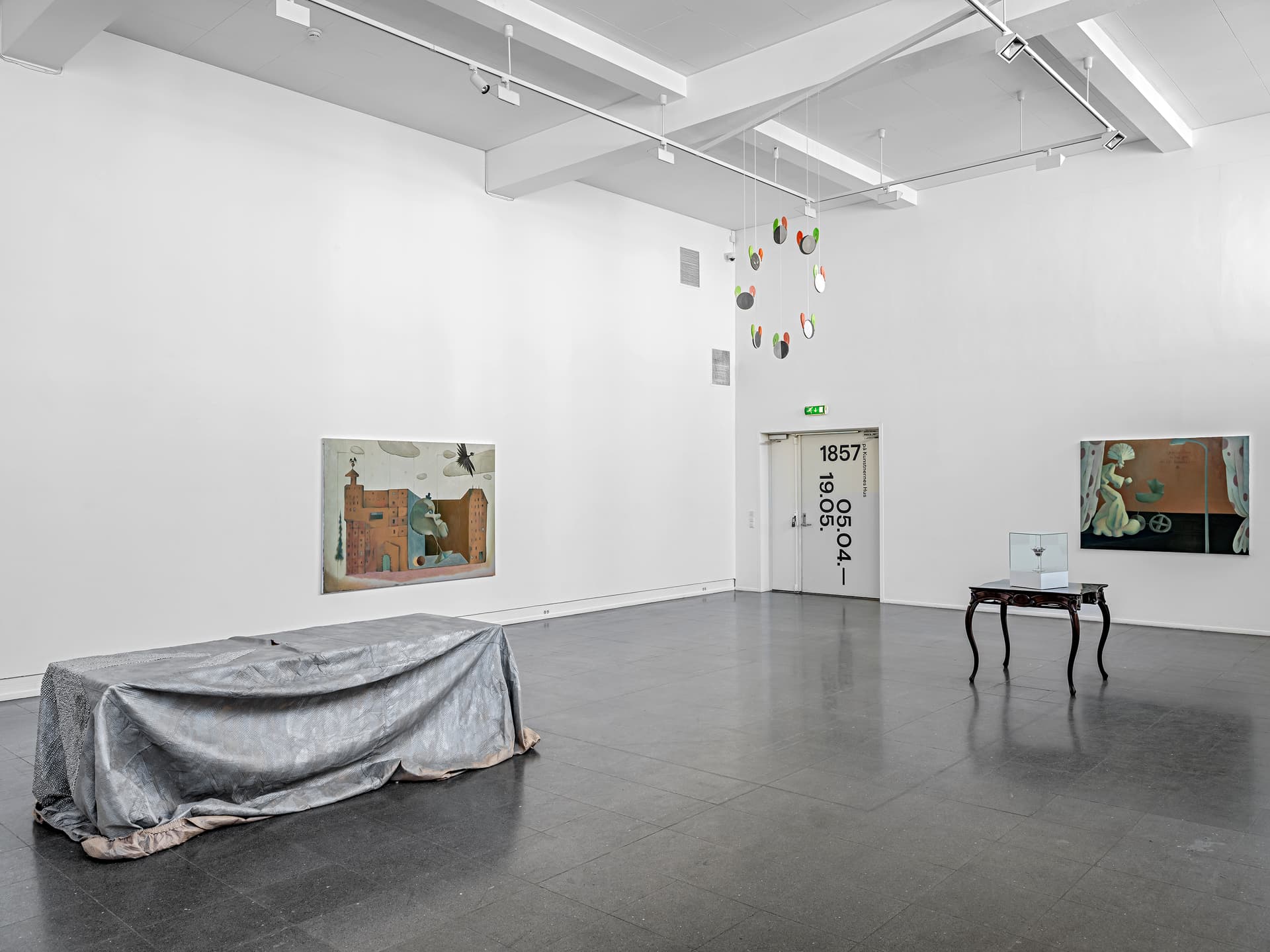Selflessness

1857 is proud to be presented by Kunstnernes Hus, and to offer, with an equal or exceeding measure of pride, a presentation of six artists who are, on their part, bursting with pride to present the works standing, hanging, laying and basking in the presence of visitors for the duration of the show.
About the exhibition
Shapes shades shine, surfaces and the limits of surfaces, co-responding to sensory exploratory prying eyes glance askance, a stolen touch, one whiff of turpentine; cascades of composites all demanding of attention. Such is the nature of life, to engage the material world and incessantly incorporate its components, sorting among potential food, waste and fuel in order to maintain inward integrity. As the senses scan and register their environs, perceptions assemble into a unitary image-inary. In the human brain this flurry of cooperation typically takes about 200-500 milliseconds: the "nowness" of a perceptuo-motor unity. Cognition does not flow, but rather marches to syncopated rhythms that arise and subside in chunks of time.
Each sensory layer connects perception directly to brain-action. An outside observer might impute a principal representation or central control, but the internals of cognition are a bricolage of divergent processes. From the local chaos of their interactions there emerges – to the eye of the observer – a coherent pattern of behavior.
Ants are a non-visual superorganism who communicate indirectly through environmental stimuli, in what is termed stigmergy. This affords them an immediate sense of the social fabric, which makes them the world leaders in communal living. After being separated into a sub-colony, the most efficient nurses from one Lasius niger colony radically change their social status, and become more prone to foraging and less involved in nursing. The contrary happens in the remaining colony: formerly low-level nurses increase their nursing activity. The whole system even exhibits evidence of a configurational identity with a memory, since the nurses will return to their previous state when the social order is undone by returning the excised element back to the colony.
In the case of the ant colony we would – unlike that of the brain – readily admit that (i) its separate components are individuals and (ii) there is no center or localized self. Yet the whole behaves as a unit and for the observer it is as if there was a coordinating agent present at the center. Here emerges the selfless self: simple components give rise to a coherent global pattern that appears to have a central location where none is found, and yet it is essential as a level of interaction for the behavior of the whole unity.
-
selve, v.
rare.
intransitive (only G. M. Hopkins). To become and act as a unique self.
1880, G. M. Hopkins, Serm. & Devotional Writings (1959), 125: Nothing can exercise function and determination before it has a nature to ‘function’ and determine, to selve and instress, with.
Etymology: < self n.
-
The cognitive self is its own implementation: its history and its action are of one piece. What then can be said about its mode of relation with the environment? Ordinary life is necessarily one of situated agents, continually coming up with what to do faced with ongoing parallel activities in their various perceptuo-motor systems. This continual re-definition of what to do is not at all like a plan, stored in a repertoire of potential alternatives, but enormously dependent on contingency, improvisation, so much more flexible than planning.
Situatedness means that a cognitive entity has – by definition – a perspective. It does not relate to its environment independent of its location, heading, attitudes and history. Rather, it engages through the perspective established by its own constantly emerging properties and in terms of the role this running redefinition plays in the coherence of the entire system. This distributed dynamics is inseparable from the constitution of a world, consisting of the surplus of meaning and intentions carried by situated behavior. If the links to the physical environment are inevitable, the uniqueness of the cognitive self is this constant genesis of meaning. Or, to invert the description, the uniqueness of the cognitive self is this constitutive lack of signification that must be supplied faced with the permanent perturbations and breakdowns of the ongoing perceptuo-motor life. Cognition is action about what is missing, filling the fault from the perspective of a cognitive self.
"A complete life may be one ending in so full identification with the non-self that there is no self to die."
– Bernard Berenson
The essential arbitrariness of our definitions of self, of organismic identity and individuality, is made all the more striking by considering the case of a moth. Here is a being that undergoes radical bodily change between egg and chrysalis, between pupa and winged insect; and yet the only time we say it dies is after the adult moth form stops moving its wings, despite the other metamorphoses that nonetheless preserved its genetic makeup. We might as easily have chosen to consider the transfer from egg to chrysalis or from chrysalis to moth as "death" – and construed the demobilization of the moth as a sloughing-off similar to the shedding of a skin.
About
Tora Dalseng (b. 1982, Tromsø, Norway) lives and works in Oslo. Recent solo exhibitions include "LUCKY NIGHT" at Noplace, Oslo; "Psycho Analytic" at Oslo Utmark; “X4" at Kunsthall Stavanger; "Snow White" at Podium, Oslo; and “Symmetry" at UKS, Oslo. Group shows include "Uummannarsuaq" at 1857, Oslo; "The 9th Norwegian Sculpture Biennale" at Vigeland-museet, Oslo; "DNB Savings Bank Foundation Artist Grant" at Oslo Kunstforening; "Walk like a giant" at QB Gallery, Oslo; and "Pattern Drill" at Hacienda, Zürich.
Ane Graff (b. 1974, Bodø, Norway) lives and works in Oslo. Recent and upcoming exhibitions include "The Goblets" at 1857, Oslo; "Earth – Body" at Museo de Geología UNAM, Mexico City; the Art Encounters Biennial 2019, Timișoara, Romania; "Soon Enough: Art in Action", Tensta Konsthall, Stockholm; “Myths of the Marble”, Henie Onstad Kunstsenter, Oslo, and the Institute of Contemporary Art, Philadelphia; the 11th Gwangju Biennale “The Eighth Climate (What Does Art Do?)”, Gwangju; and ”Surround Audience -The New Museum Triennial 2015", NY. Ane Graff is part of "Weather Report – Forecasting Future" at the Nordic Pavilion at the 58th Venice Biennale, curated by Leevi Haapala and Piia Oksanen of KIASMA, Helsinki.
Anthea Hamilton (b. 1978, London) recently opened the solo exhibition "The Prude" at Thomas Dane Gallery (2019). Recent shows include "The New Life", Secession, Vienna (2018) and "The Squash: Duveens Commission", Tate Britain, London (2018) as well as The Hepworth Wakefield, Wakefield; Glasgow International; Schinkel Pavillon, Berlin; 13th Biennale de Lyon; Palais de Tokyo, Paris; and Tate Britain, London; SculptureCenter, New York and Public Fiction, Los Angeles. She was shortlisted for the Turner Prize in 2016.
Mikael Øye Hegnar (b. 1984) lives and works in Oslo. Recent exhibitions include “Garderoben” at Kristiansand Kunsthall; "MNikael ∞ benspenn”, Kunstnerforbundet, Oslo; "Drawing biennale 2016: SKISSEN”, LNM, Oslo; "Neolithic Graffiti”, QB Gallery, Oslo; “Blotto" Galleri BOA, Oslo; “Øy", Elephant Kunsthall, Lillehammer, Norway. An upcoming solo presentation with 1857 will take place at Solvang allotment gardens, Oslo.
Mirak Jamal (b. 1979, Tehran, Iran) lives and works in Berlin, Germany. Recent solo exhibitions included "Full Circle", Galerie Sultana, Paris; Group shows include "Doors of Paradise", Union Pacific, London; "My Body Doesn't Like Summer” at Galerie Haverkampf, Berlin; "La réalité viscérale", Les Bain Douches, Alencon; and the 15th Istanbul Biennial “a good neighbour” at Istanbul Modern Museum.
Nancy Lupo(b. 1983, US) lives and works in Los Angeles. Recent and upcoming solo exhibitions include Jan Kaps, Cologne (2019); UT Austin’s Visual Arts Center, Austin (2019); Antenna Space, Shanghai (2018); Kristina Kite Gallery, Los Angeles (2017); Swiss Institute, New York (2016); 1857, Oslo (2015). Her work has been included in group exhibitions at the Hammer Museum, Los Angeles (2018); Musée d’art contemporain de Lyon, France (2017); Astrup Fearnley Museet, Oslo (2016); the Museum of Contemporary Art, Los Angeles (2016); Atlanta Contemporary (2016); MoMA PS1, New York (2014); and Night Gallery, Los Angeles (2013), among others.
-
1857 was founded in 2010 by Steffen Håndlykken and Stian Eide Kluge, who were joined by Jenny Kinge in 2015. They produced exhibitions by young, international artists in a former lumberyard in downtown Oslo until 2018 when the lease on the space expired. A program of solo presentations in temporary locations runs through 2019. 1857 remains, for the time being, a place to convene and converge, receive, answer and honour contemporary art in Oslo.





